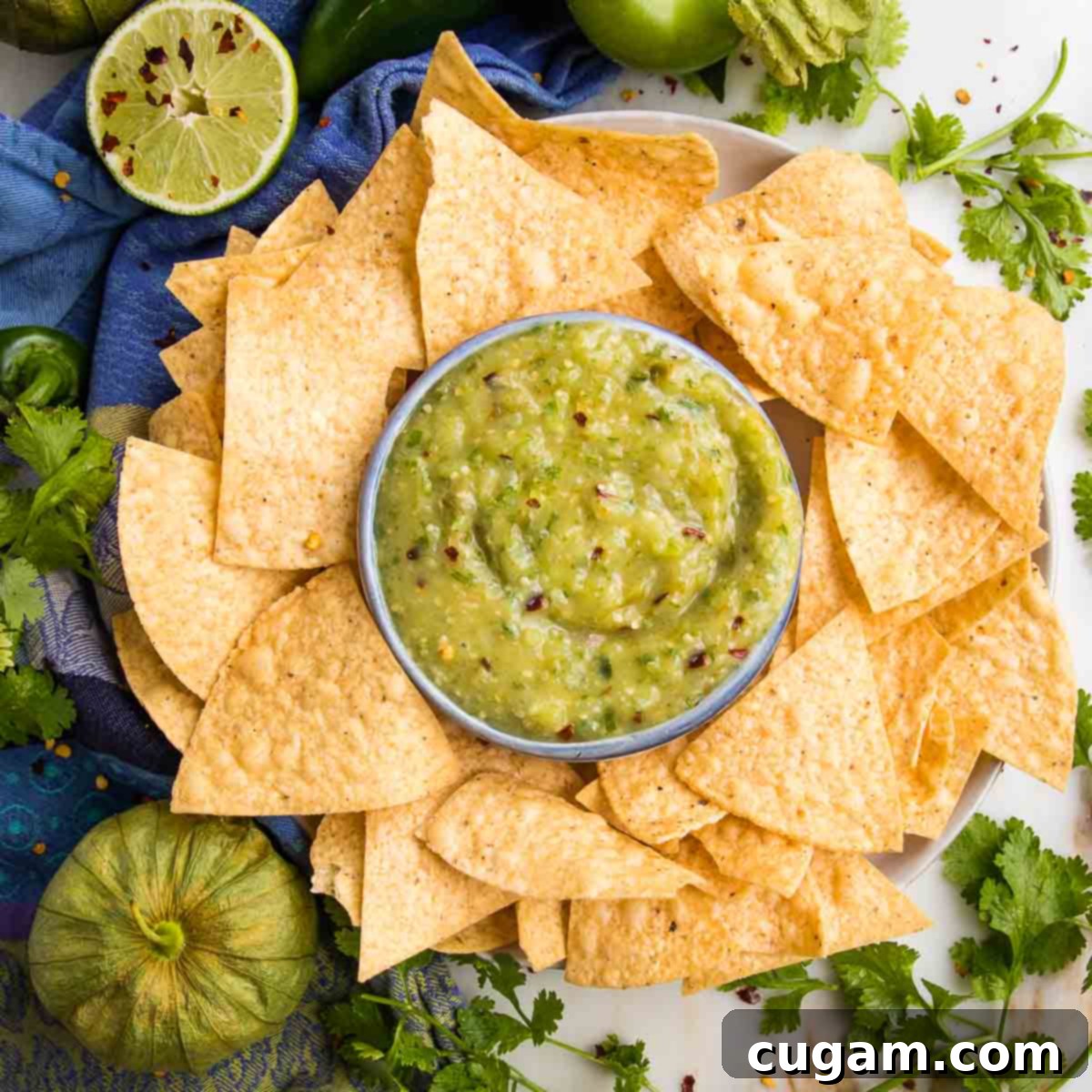Authentic Roasted Tomatillo Salsa Verde: The Best Homemade Recipe
Prepare to elevate your taste buds with our incredible Homemade Roasted Tomatillo Salsa Verde! Forget the store-bought versions; once you experience the vibrant, complex flavors of fresh tomatillos roasted to perfection with spicy jalapeños, sweet onions, and aromatic garlic, you’ll never go back. This green salsa verde isn’t just bursting with amazing taste; it’s also wonderfully low in calories and carbs, making it a guilt-free addition to any meal.
Whether you’re looking for a delightful vegan appetizer to serve with crispy tortilla chips or a versatile sauce to transform your favorite enchilada recipes, this roasted tomatillo salsa is your answer. Its fresh, tangy, and subtly smoky profile is a game-changer for Mexican cuisine and beyond.
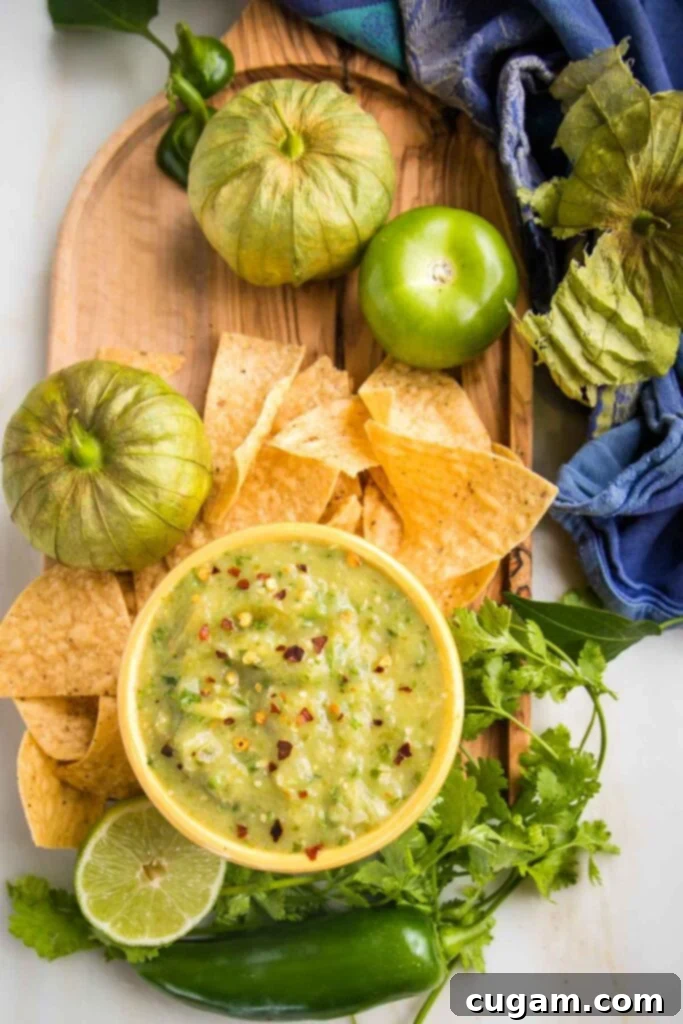
This post has been updated from the original posted August 26, 2015, to provide even more details, tips, and an improved recipe for the best roasted tomatillo salsa verde.
Why Homemade Roasted Tomatillo Salsa is a Must-Try
The difference between homemade and store-bought salsa verde is truly incomparable. While commercial varieties can be convenient, they often lack the depth, freshness, and nuanced flavors that come from making it yourself. Fresh tomatillos are readily available at most local farmer’s markets and grocery stores, especially from early summer through fall. They are not only a nutritional powerhouse, packed with antioxidants, but they also form the foundation of the most delicious green salsa imaginable.
Roasting the tomatillos, along with the jalapeño pepper, onions, and garlic cloves, is the secret to unlocking their peak flavor potential. This crucial step mellows their natural tartness and introduces a smoky sweetness that simply can’t be achieved with raw ingredients. The result is a richer, more complex salsa that stands head and shoulders above its unroasted counterparts. If you’re accustomed to traditional tomato salsa, this roasted tomatillo version offers a delightful and refreshing change that you’ll quickly fall in love with.
Understanding Tomatillos: The Heart of Salsa Verde
Often mistaken for green (unripe) tomatoes, tomatillos are distinct small fruits covered in a papery husk. They are a staple in Mexican cuisine, primarily celebrated for their role in salsa verde. When raw, tomatillos boast a distinctly acidic and tart flavor, which some enjoy in salads or raw salsas, but many prefer to cook them to transform this tang into a more savory, mellow profile. Roasting is arguably the best cooking method for tomatillos, as it caramelizes their natural sugars, intensifying their sweetness and depth while softening their texture.
Beyond salsa, cooked tomatillos can be braised in stews, sautéed into stir-fries, or incorporated into various other vegetable dishes. Their versatility makes them a valuable ingredient for any home cook looking to explore vibrant, fresh flavors.
Key Ingredients and Smart Substitutions
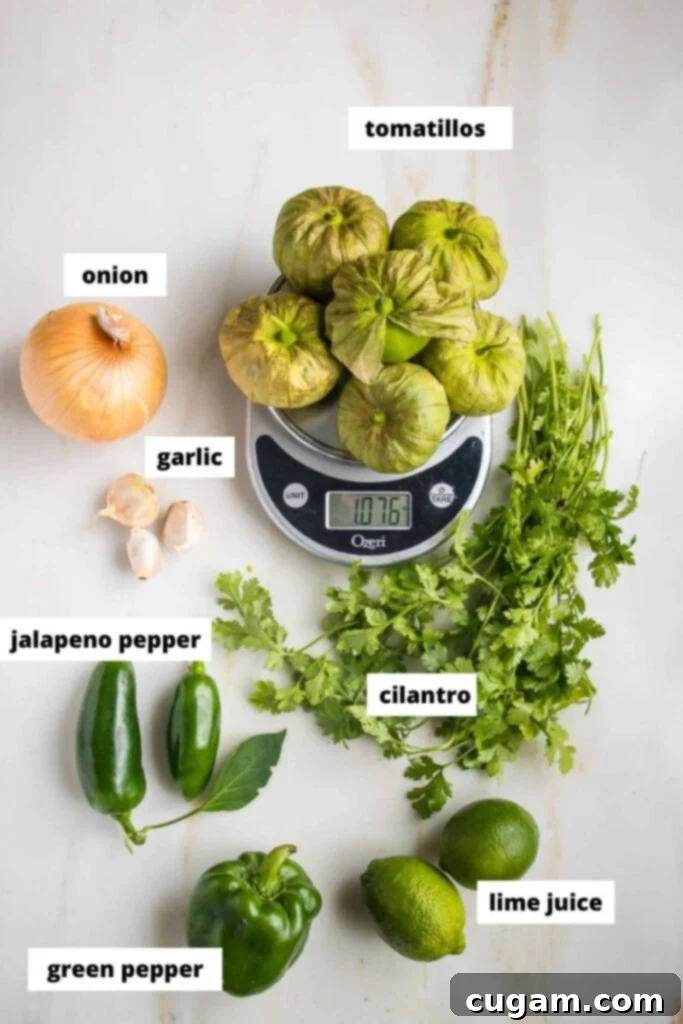
- Tomatillos: These are the star! Their slightly acidic flavor transforms beautifully with roasting, becoming sweeter and more savory, which also makes the salsa easier on digestion. While some might use unripe green tomatoes for a “green salsa,” it’s important to note that true tomatillo salsa verde uses actual tomatillos for that authentic, unique flavor.
- Jalapeño Peppers: Jalapeños provide a mild heat and a foundational pepper flavor. For those who crave more spice, consider substituting with serrano chiles (moderately hotter) or habaneros (significantly hotter). If you prefer a milder pepper with a smoky nuance, poblano peppers are a delicious, less spicy alternative. You can also adjust the heat by removing or keeping the seeds and membranes.
- Onion: Roasting the onion alongside the tomatillos mellows its pungency, making it sweeter and easier to digest for many people who find raw onion challenging. Scallions (green onions), red onion, or even chives can be used as fresh alternatives if you choose a raw salsa approach, but for roasting, a sweet white onion works best.
- Garlic: Roasted garlic is a revelation! It loses its raw sharpness, becoming incredibly sweet, nutty, and soft, imparting a much deeper and more palatable flavor to the salsa. This is far easier on the taste buds and digestion than using raw garlic.
- Fresh Cilantro: This herb is quintessential to Mexican salsas, adding a bright, herbaceous note. Fresh herbs truly make a difference. If cilantro isn’t your preference, fresh oregano or parsley can offer a different, but still pleasant, herbal dimension.
- Green Pepper (Bell Pepper): Added raw, green bell pepper contributes a refreshing crunch and a boost of Vitamin C, adding another layer of freshness to the final blend.
- Lime: Fresh lime juice is crucial for balancing the rich, roasted flavors with a zesty, bright acidity. The citric acid also acts as a natural preservative, helping your homemade salsa stay fresh longer.
- Optional: Olive Oil & Sea Salt: A drizzle of olive oil helps the vegetables roast beautifully and prevents sticking, while a sprinkle of sea salt enhances all the natural flavors during roasting.
How to Make Roasted Tomatillo Salsa: A Step-by-Step Guide
Making your own roasted tomatillo salsa is a straightforward and rewarding process. Here’s how to do it:
1. Prepare Your Tomatillos
If this is your first time working with tomatillos, you might notice a slightly sticky film once you remove their papery husks. Don’t worry, this is completely normal! Simply rinse the husked tomatillos under warm water to remove this sticky residue. Then, cut them into quarters to ensure even roasting.
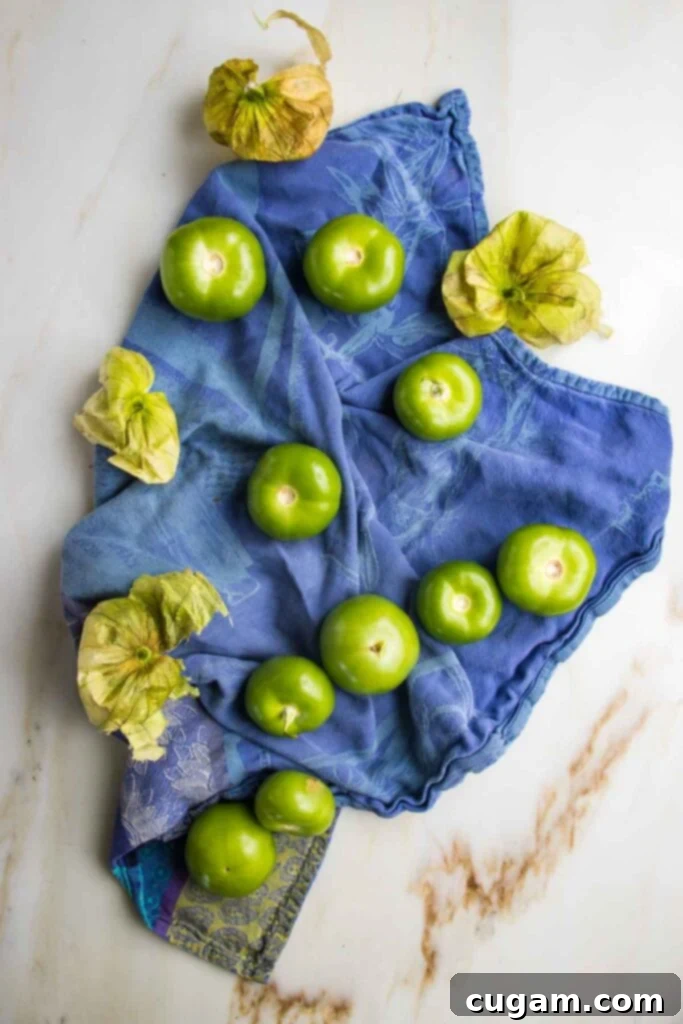
2. Prep and Roast the Vegetables
The first crucial step is to roast your core vegetables: tomatillos, onion, garlic, and jalapeños. For the jalapeño, cut it in half lengthwise, through the stem. The easiest way to remove the seeds and membranes (which contain most of the heat) is with a grapefruit spoon or a small paring knife. If you desire a spicier salsa verde, feel free to leave a few seeds in the jalapeños before roasting them with the other veggies.
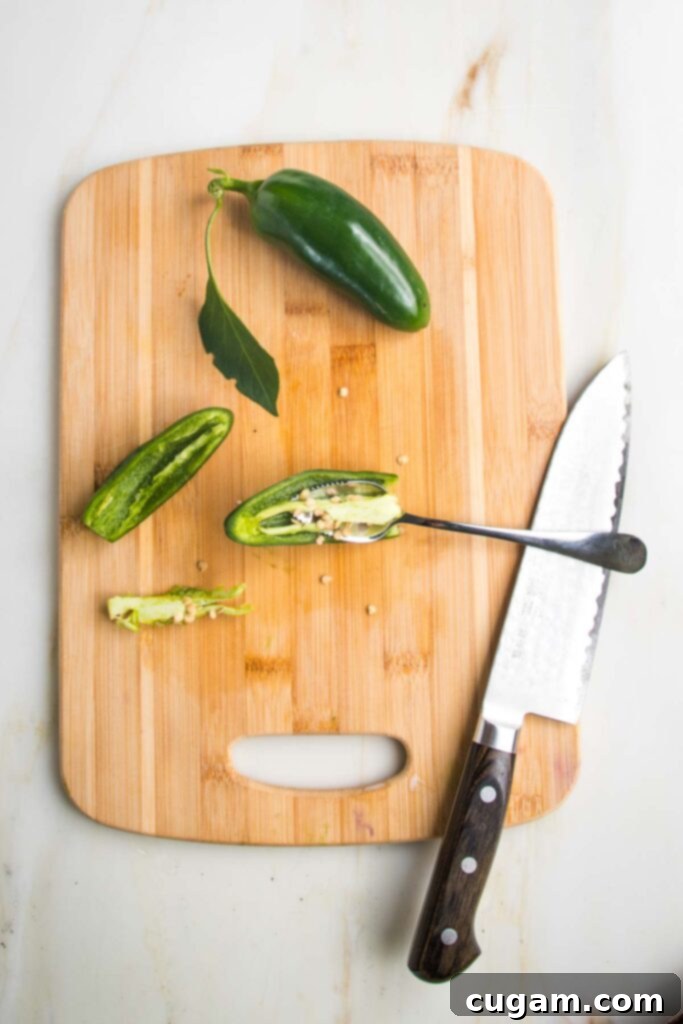
Arrange your prepped vegetables in a single layer on a heavy rimmed baking sheet. Keep the skins on the garlic cloves; this prevents them from burning and helps them steam inside, resulting in a soft, sweet pulp. OPTIONAL: Drizzle the vegetables with a little olive oil and sprinkle with sea salt before roasting. Roast in a preheated 450°F (232°C) oven for about 15 minutes, or until the tomatillos are soft and slightly charred, and the onions are translucent.
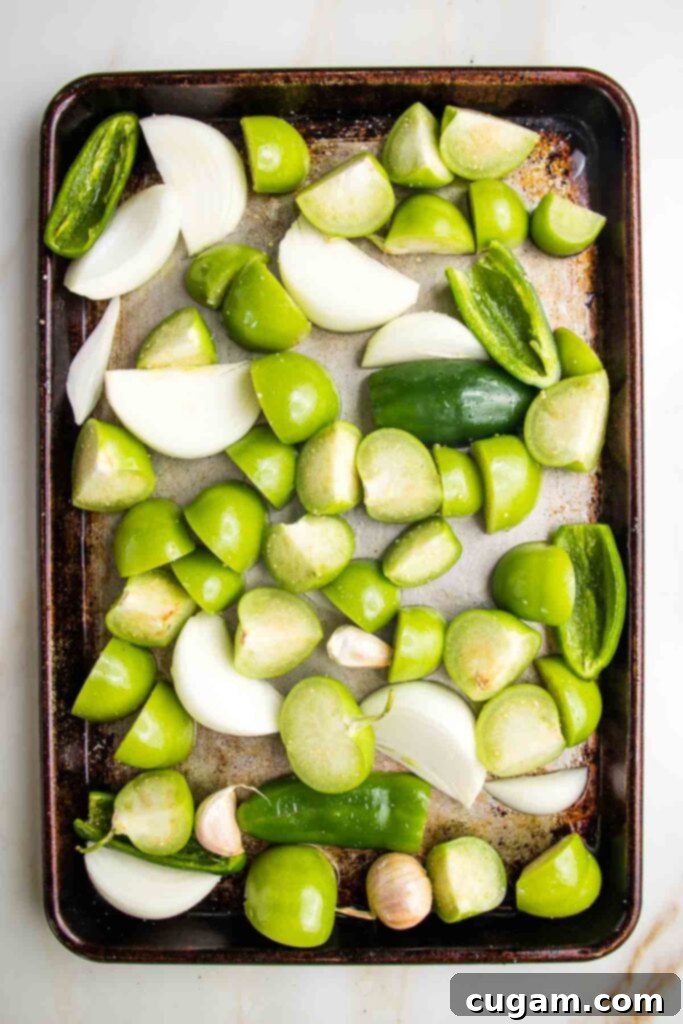
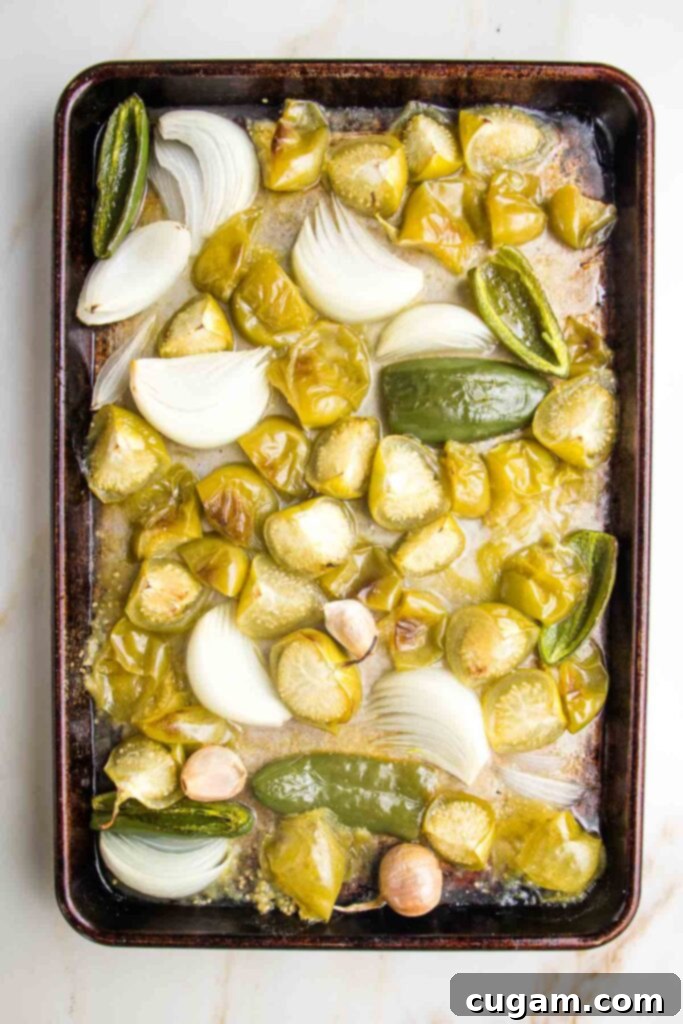
3. Blend to Perfection
Carefully scoop all the roasted vegetables, including any delicious juices that have accumulated on the baking sheet, into the bowl of a food processor. If you don’t have a food processor, a blender will work just as well. The skins on the roasted garlic cloves should now peel off easily, or you can simply squeeze out the soft, sweet pulp and discard the skins. Process the roasted mixture until it achieves a creamy, uniform texture.
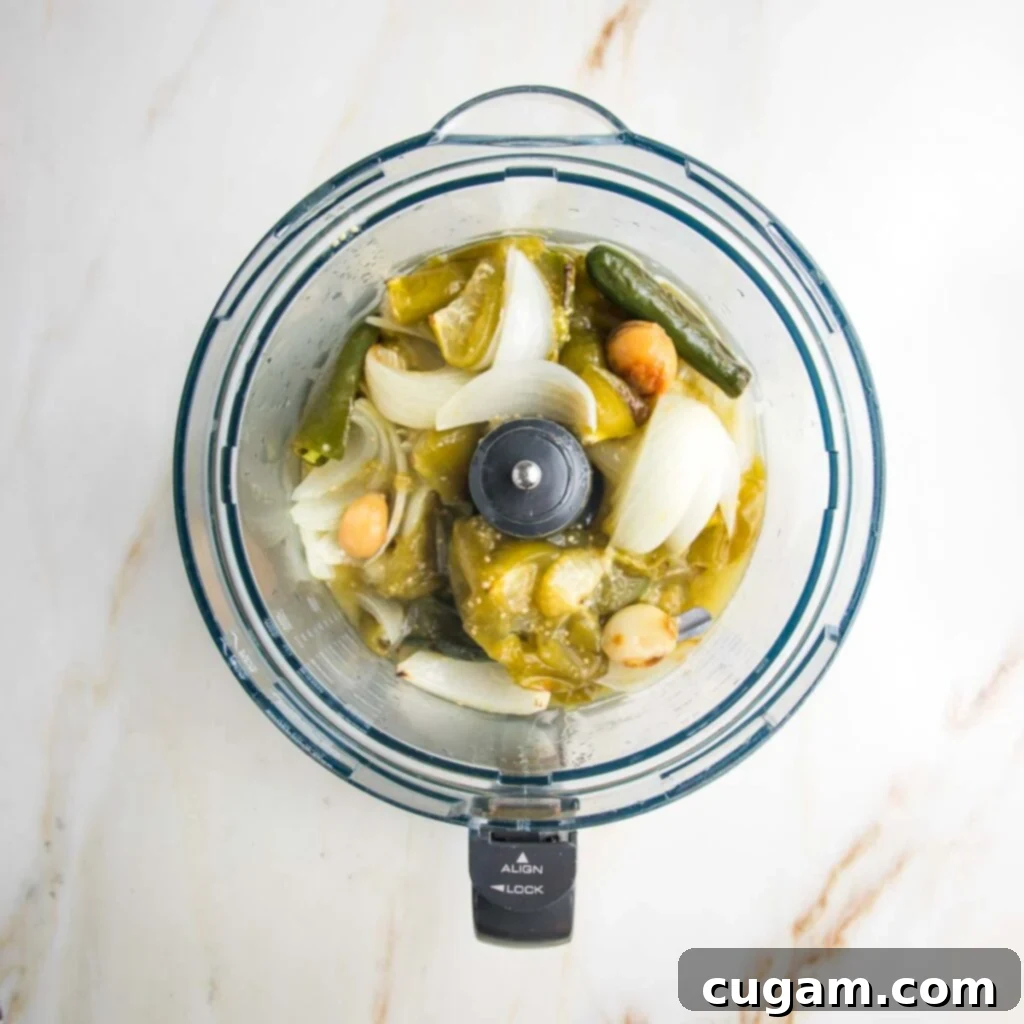
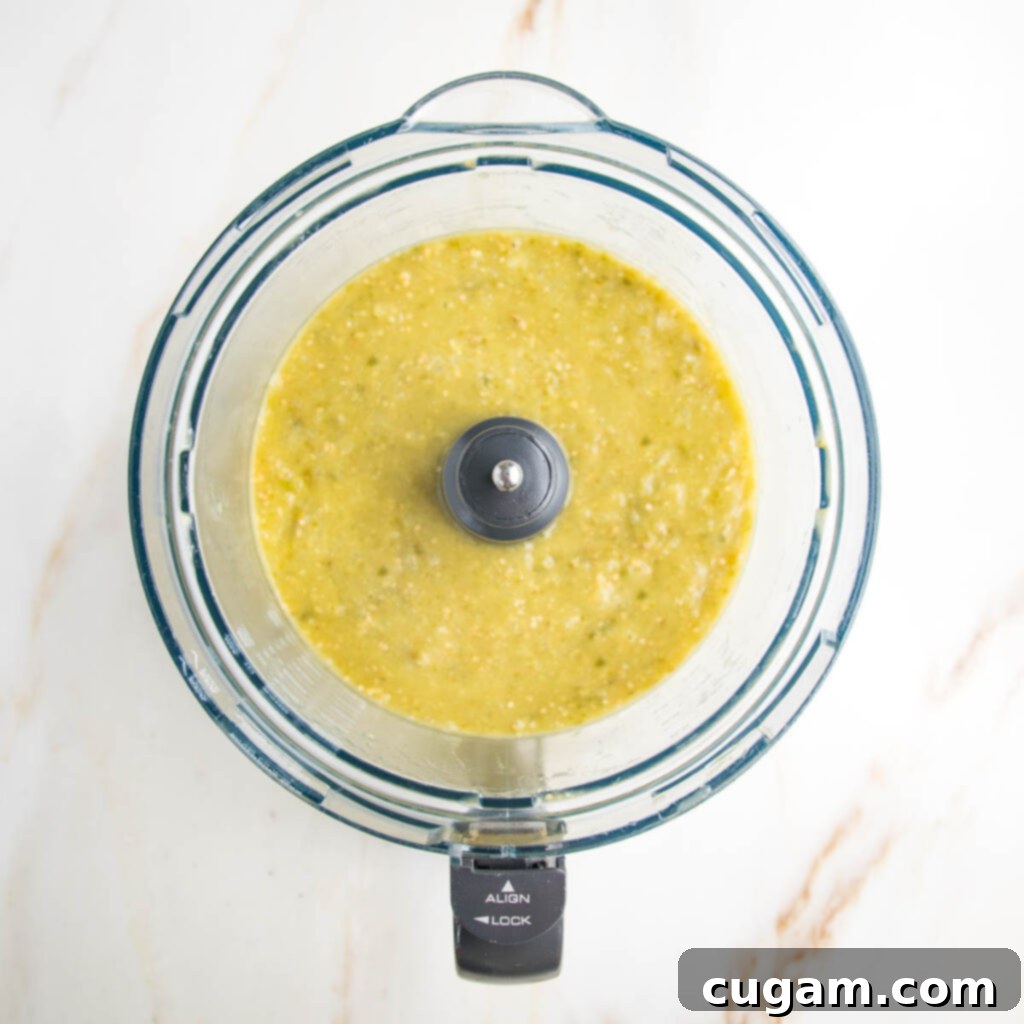
4. Add Fresh Elements and Season to Taste
Now, add the raw green bell pepper (stemmed and seeded), fresh cilantro, and the juice of one lime to the food processor. Process again until all the ingredients are well incorporated, but still maintaining some texture from the fresh additions. Taste the salsa and adjust seasonings as needed. For a spicier kick, stir in some crushed red pepper flakes or a pinch of cayenne pepper. Add more lime juice for extra zing, or a pinch of sea salt to enhance all the fresh vegetable flavors. Remember, the perfect salsa is all about balancing taste to your personal preference!
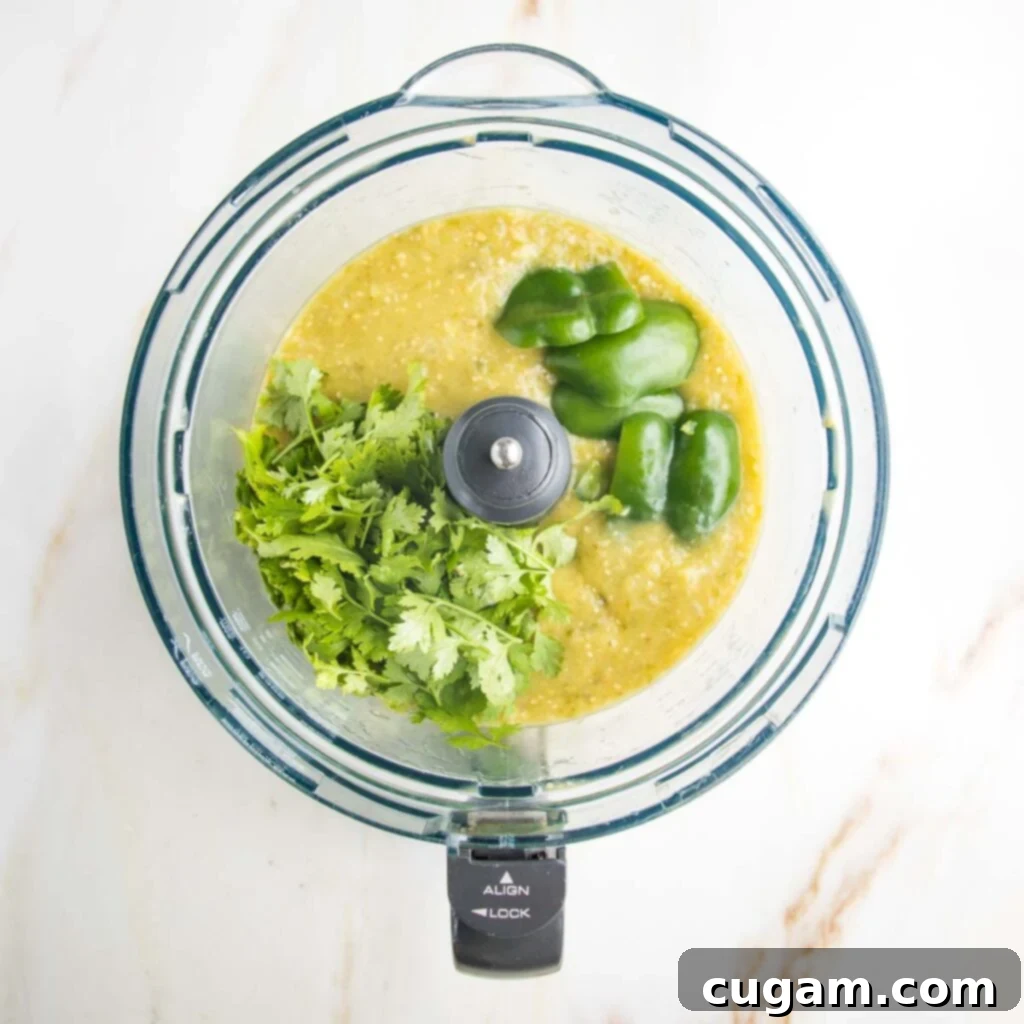
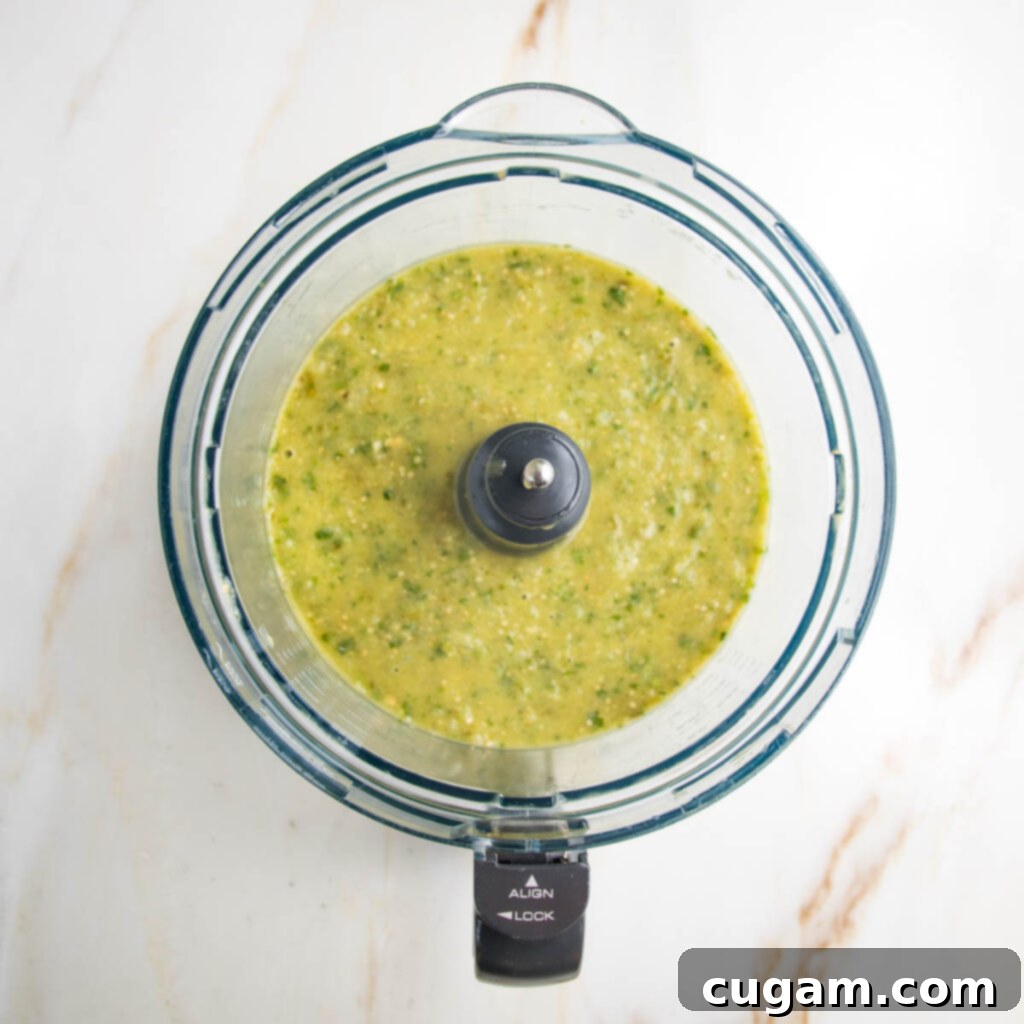
Roasted tomatillo salsa is best served at room temperature to allow its full array of flavors to shine. Garnish with a sprinkle of crushed red pepper for a touch of heat, and serve with your favorite tortilla chips or as a vibrant accompaniment to any Mexican-inspired dish. Enjoy the rich, authentic taste of your homemade green salsa verde!
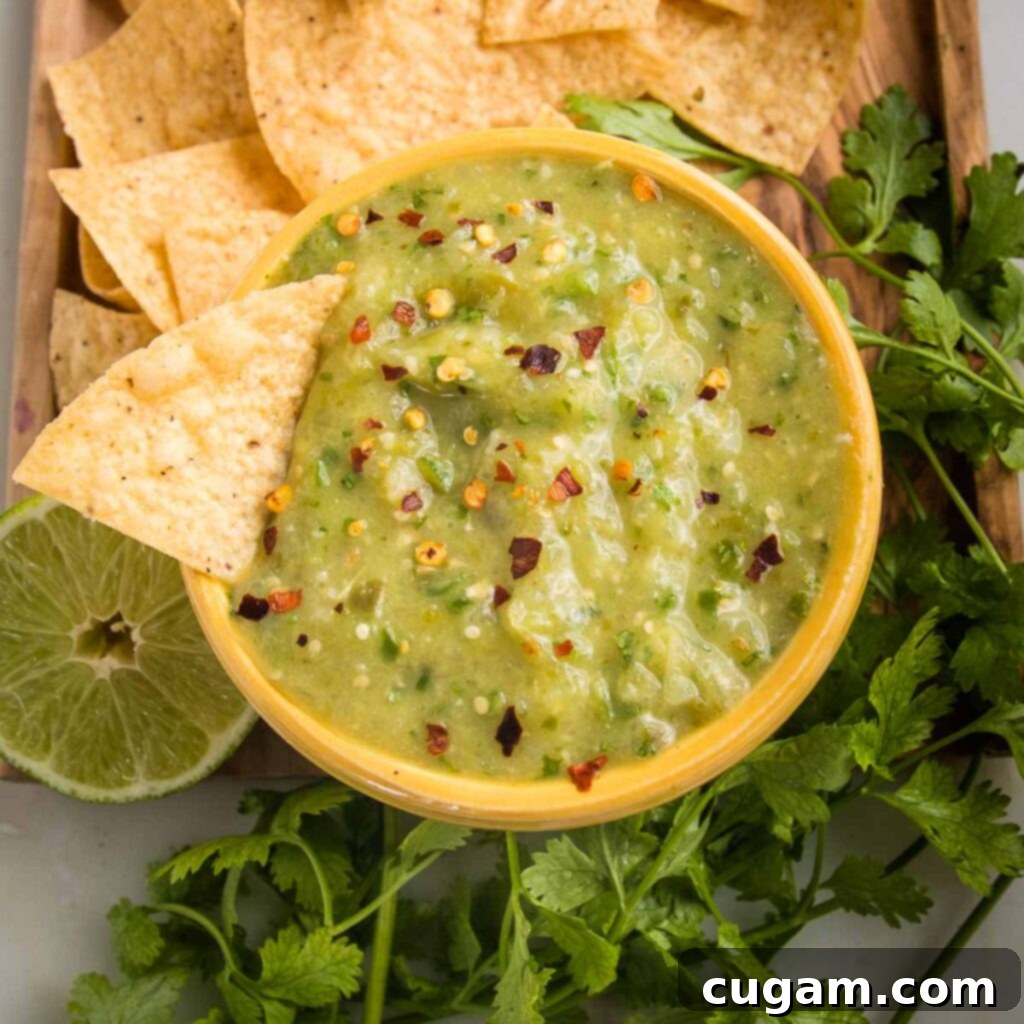
Debra’s Pro Tips for the Best Salsa
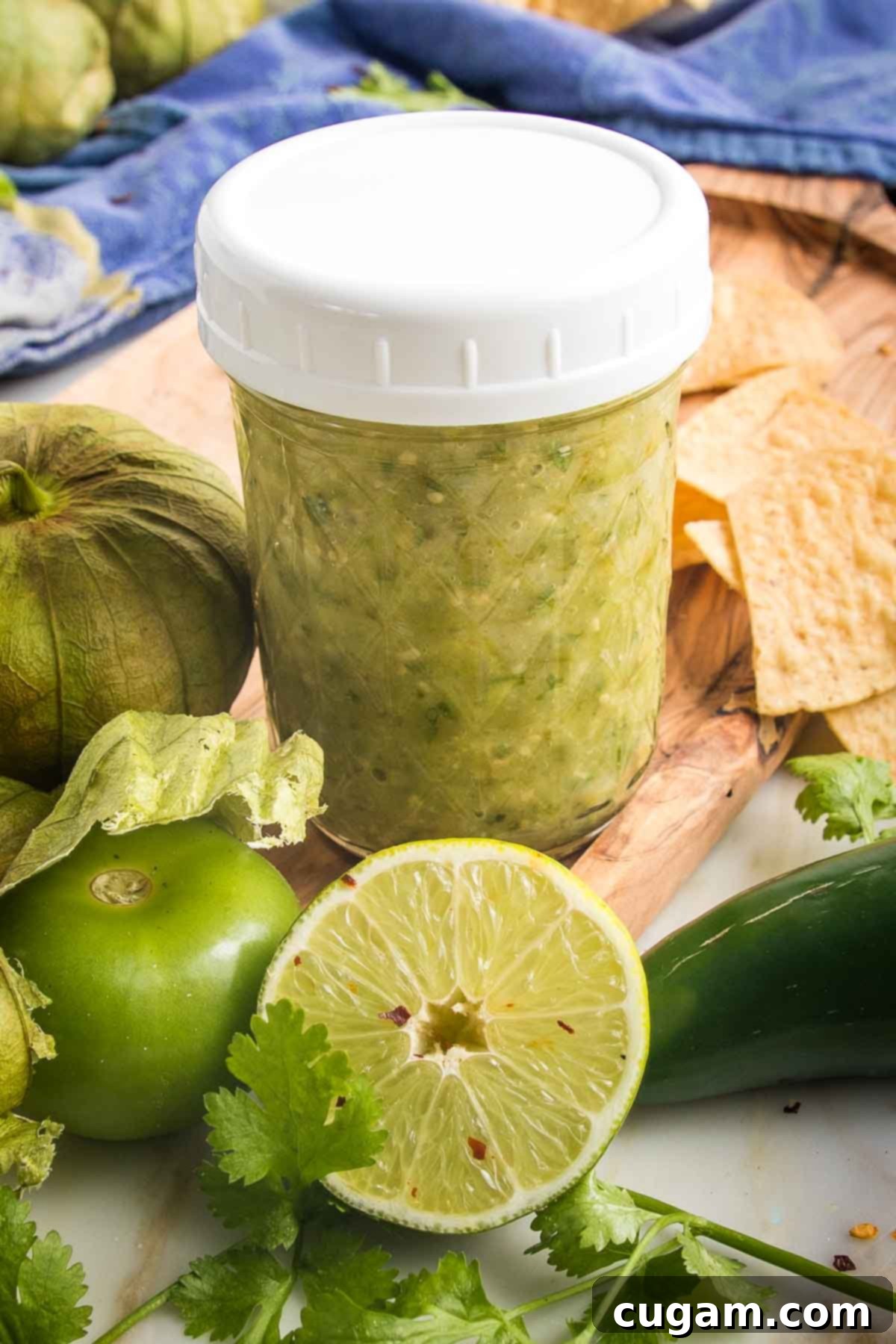
- Breakfast Boost: Transform your breakfast routine by adding a generous drizzle of this vibrant tomatillo salsa over some scrambled tofu. It’s an unbeatable combination for breakfast tacos or a healthy morning bowl.
- Maximize Flavor & Texture: Don’t discard the juices left on the baking sheet after roasting! These flavorful liquids are essential for achieving the perfect consistency and adding extra depth to your blended salsa.
- Thoughtful Gift Idea: Homemade salsa makes a fantastic hostess gift. Pour it into a charming mason jar, tie a pretty ribbon around it, and you have a unique and delicious present for any potluck or dinner invitation.
- Quick Raw Alternative: While I wholeheartedly recommend roasting for the deepest flavor, if you’re truly short on time, you can make a raw tomatillo salsa. Simply husk, rinse, and chop your tomatillos. Combine them with scallions (instead of roasted onions), fresh jalapeños, green bell pepper, cilantro, lime juice, and just one clove of raw garlic in your blender or food processor. Blend until you reach your desired salsa consistency, adding a bit of water if needed to achieve smoothness.
Versatile Serving Suggestions
This roasted tomatillo salsa is incredibly versatile and can be enjoyed in countless ways:
- Classic Dip: Serve it simply with warm, crispy tortilla chips for an irresistible snack or appetizer.
- Taco & Burrito Topping: Ditch boring sauces and spoon generous dollops onto your favorite tacos, burritos, or burrito bowls.
- Enchilada Sauce: This salsa is perfect as a vibrant, fresh green enchilada sauce. Pour it over your enchiladas before baking for an authentic Mexican flavor.
- Egg Enhancer: Brighten up scrambled eggs, omelets, or huevos rancheros with a spoonful of this zesty salsa.
- Grilled Meats & Fish: Use it as a fresh topping for grilled chicken, fish, or steak to add a pop of flavor.
- Grain Bowls & Salads: Incorporate it into healthy grain bowls or use it as a flavorful dressing for salads.
- Soup & Stew Base: Add a few tablespoons to a Mexican-inspired soup or stew for an instant flavor boost.
Meal Prep and Storage Tips
- SERVE: This salsa is fantastic served at room temperature or chilled. Its versatility makes it a great sauce for grain bowls, tacos, enchiladas, burritos, or salads.
- PREP AHEAD: To save time, you can roast the vegetables a day or two in advance. Store them in an airtight container in the refrigerator until you’re ready to proceed with blending the salsa.
- STORE: Once prepared, store your homemade roasted tomatillo salsa in an airtight container in the fridge for up to 2 weeks. The lime juice helps maintain its freshness!
- FREEZE: Roasted Tomatillo Salsa freezes beautifully and can be stored for up to 6 months. For easy thawing and portion control, use one-cup silicone molds to freeze larger portions for dipping or as a sauce. Alternatively, freeze it in tablespoon-sized ice cube trays. These smaller cubes are perfect for easily adding a burst of flavor to soups, stews, or other recipes whenever you need it.
Frequently Asked Questions (FAQ)
- What is the difference between tomatillos and green tomatoes? While they look similar, tomatillos and green tomatoes are different plants. Tomatillos have a distinctive papery husk and a more tart, acidic flavor than tomatoes. Green tomatoes are simply unripe regular tomatoes and tend to be less acidic and have a different texture. For authentic salsa verde, always use tomatillos.
- How do I choose ripe tomatillos? Look for firm, bright green tomatillos with husks that are tightly wrapped and relatively dry. Avoid those with soft spots or yellowing husks, as these may be overripe. The husk might split as they ripen, but the fruit inside should still be firm.
- Can I make this salsa without roasting the vegetables? Yes, you can make a raw tomatillo salsa (sometimes called “salsa cruda”). However, roasting the vegetables (especially the tomatillos, onions, and garlic) mellows their tartness, adds a smoky depth, and significantly enhances the overall flavor profile. For the best result and a richer taste, roasting is highly recommended.
- How can I make this salsa spicier or milder? To increase the heat, use serrano or habanero peppers instead of jalapeños, or leave some of the seeds and membranes in the jalapeños before roasting. You can also add a pinch of cayenne pepper or more red pepper flakes after blending. For a milder salsa, ensure you remove all seeds and membranes from your chosen chili pepper.
- Can I use a blender instead of a food processor? Absolutely! Both a food processor and a blender will work well for this recipe. A food processor might give you a slightly chunkier salsa if you prefer, while a blender will typically produce a smoother consistency. Just be careful not to over-process, especially after adding the fresh ingredients, to maintain some texture.
More Mexican-Inspired Healthy Recipes
- Healthy Cinco de Mayo Recipes
- Homemade No-Salt Taco Seasoning
- Easy Vegan Mexican Street Corn (Esquites)
- The Best Homemade Guacamole
- Fresh Tomato Pico de Gallo
- Flavorful Vegan Enchiladas
- Oven-Roasted Mexican Cauliflower Rice
- Creamy Vegan Chipotle Dressing
- Hearty Vegan Taco Soup
Did you know commenting and rating recipes is one of the best ways to support your favorite food bloggers? If you made this delicious Roasted Tomatillo Salsa recipe, please consider leaving a five-star rating below and a comment sharing your experience. Also, we’d love to see your culinary creations! Please share your photos on Instagram by tagging me @dkhealthcoach and using the hashtag #debraklein. Your support means the world!
📖 Recipe: Roasted Tomatillo Salsa Verde

Roasted Tomatillo Salsa
Rate this Recipe
Pin Recipe
Equipment
-
Grapefruit Spoons
-
Stainless Steel Heavy Baking Sheet
-
Food Processor
Ingredients
- 1 lb. fresh tomatillos about 6 medium tomatillos
- 1 sweet white onion
- 1-2 hot green chiles*
- 3 large cloves garlic
- ⅓ cup cilantro leaves
- 1 small green pepper
- 2 limes juiced
- OPTIONAL: 2 Tablespoons olive oil
- OPTIONAL: ½ teaspoon sea salt
Instructions
-
Preheat oven to 450°F (232°C).
-
PREP VEGGIES FOR ROASTING: Husk tomatillos and thoroughly rinse the sticky residue off with warm water. Cut them into quarters. Cut green chiles (like jalapeños) in half lengthwise through the stem. Use a grapefruit spoon or paring knife to scoop out the seeds and membranes if you prefer less heat. Remove the papery skin from the onion, then cut it into quarters.
-
Place the prepped tomatillos, chiles, and onion onto a heavy rimmed baking sheet. Add whole garlic cloves with their papery skin still on. Drizzle with olive oil (if using) and sprinkle with sea salt (if using). Toss well to ensure all vegetables are coated, then distribute them in a single layer. Roast in the preheated oven for 15 minutes, or until the vegetables are soft and slightly caramelized.
-
Carefully transfer all roasted vegetables (including any pan juices) to the bowl of a food processor. The garlic skins will peel off easily; squeeze out the soft pulp and discard the skins. Process until the mixture is uniform in texture and creamy.
-
Stem and seed the small green bell pepper, then add it to the food processor along with the fresh cilantro leaves and the juice of one lime. Process again until everything is well incorporated but still retains some fresh texture. Taste for seasoning. Add crushed red pepper for extra heat, additional salt, or more lime juice as desired to perfect the flavor balance.
-
Store your delicious homemade salsa in an airtight container in the refrigerator for up to two weeks. Enjoy!
Notes
Nutrition
Note
The nutrition calculations were done using online tools. To obtain the most accurate representation of the nutritional information in any given recipe, you should calculate the nutritional information with the actual ingredients you used. You are ultimately responsible for ensuring that any nutritional information is accurate, complete and useful.
